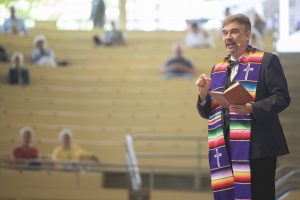
SARAH YENESEL/STAFF PHOTOGRAPHER
“I hope that none of you jumped to the erroneous conclusion that by seeing through the eyes of the marginalized, there is a clear dichotomy between the oppressor and the oppressed,” Miguel A. De La Torre said. “I am a light-skinned, Latino, cisgender male, and I have had to deal with the complexity of the whitening of darker people in my culture.”
His sermon title was “Marrying Down,” and the Scripture reading was Numbers 12:1-3, 10, Miriam and Aaron complaining about Moses.
“I have had an infected mind since childhood — ‘if you are white, you are more beautiful.’ ” he said. “This is Sleeping Beauty and Snow White. I had to decolonize my mind to understand true beauty. If we read these verses through the eyes of the dominant culture, they don’t make much sense. You are probably sitting there thinking, ‘What is he going to do with them?’ ”
In order to understand how to read with a decolonized mind, De La Torre had to read African American, Asian, queer, Latinx and Native American writings about Scripture.
“I was responsible for learning how to read through the eyes of others, so I had to buy and read their books,” he said.
In Numbers, Miriam and Aaron are upset because Moses had married a Cushite woman. The Cushite people lived south of Egypt.
“In other words,” De La Torre said, “they were black.”
Miriam and Aaron were angry because they thought Moses was putting on airs. They said, “God can speak through us, too.”
“Am I reading white culture into the Bible?” De La Torre asked. “Such a reading assumes that Moses was white. There were no white people in that region at that time. We are reading the Scripture as it was never meant to be read.”
He continued, “Since the 1930s, ’40s, ’50s, ’60s, ’70s, ’80s, until now, this passage had been used to preach against interracial marriage. It is important to deconstruct this text.”
Miriam and Aaron were not angry because Moses was marrying down; he was marrying up. The Cushites had an empire, land and actual economic worth.
“The Hebrews had nothing,” De La Torre said. “Miriam and Aaron were telling Moses, ‘You think you are hot stuff, that God can only talk to you.’ ”
De La Torre told the congregation to be careful about reading skin color into the Bible. It was not a concept the Biblical writers knew.
“Think about pictures of Adam and Eve with blonde hair,” he said. “The Bible says that Adam was made from the soil, and I have never seen white soil. I am no farmer, but I know that the best soil is very, very black.
“If this is true, then the Mark of Cain was not to make Cain black, but the Mark of Cain made him white,” De La Torre continued. “The text says Miriam was made white. We could have fun with this.”
If Jesus was white, then his father had to be a Roman soldier, because they were the only white people in Judea, De La Torre said.
“The only place in the Bible where there is a physical description of Jesus is Revelation 1:14-15 — he has white wooly hair and skin the color of brass,” De La Torre said. “When a culture makes race important, we have to look at what Scripture says, and we will have to debunk any racist interpretation. We could ask why only Miriam was punished, but we won’t address that today.”
In this culture, no matter how hard we try, we have been taught to read the Bible through the eyes of the oppressor, he said. We have been told it is an objective reading.
“We have to push back because there is no such thing as an objective reading,” De La Torre said. “We can read racism, sexism, heterosexism into the Scriptures. We have to read with the eyes of the marginalized.”
He noted that many of his compadres’ minds are colonized to the extent that they are put on TV or praised from major platforms to prove how objective the dominant culture is.
“To read from the margins is to grasp the divine in the midst of oppression and struggle,” De La Torre said.
The Rev. Susan McKee presided. The Rev. Steve Aschmann, a United Church of Christ minister who is president of Chautauqua PFLAG, facilitates the Chautauqua dialogue at the African American Heritage House and serves on the board of the Chautauqua Unitarian Universalist Fellowship, read the Scripture. The introit, sung by the Motet Choir, was “May the Words of Our Mouths,” by John Ness Beck. The choir sang “The Lord’s Prayer,” by John Tavener, as the anthem. Jared Jacobsen, organist and coordinator of worship and sacred music, directed the Choir. Thanks to the generosity of several people who met at Chautauqua, there are a few braille worship books and hymnals available at morning worship for sight-impaired people. The books are available to Gate 4, the Ralph C. Sheldon Gate. Ask any usher for assistance. The Daney-Holden Memorial Chaplaincy and the John William Tyrrell Endowment for Religion provide support for this week’s services.
Note: On Monday, Aug. 19, George Wolfe, alto saxophone, and Arlene Hajinlian, piano, performed “Interlude” from Sonata in the style of Francis Poulenc for alto saxophone and piano, by Wijnand van Klaveren, as the prelude. The performance was dedicated to the memory of Richard Kemper, a dedicated Motet Choir member.




